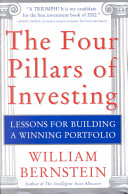

The first pillar of investing is the theoretical underpinning of investment strategies, which encompasses the foundational principles of economics and finance. This pillar emphasizes the importance of understanding how markets operate, the nature of risk and return, and the role of diversification. It explains concepts like the efficient market hypothesis, which suggests that asset prices reflect all available information, and the capital asset pricing model (CAPM), which relates the expected return of an asset to its systematic risk. Investors are encouraged to grasp these theories to make informed decisions, as they provide a framework for analyzing investments and understanding market behavior.
Continue readingThe second pillar is the historical perspective on investing, which examines how markets have behaved over time. This pillar provides insights into past market cycles, crises, and recoveries, helping investors learn from history. The author discusses major events like the Great Depression, the dot-com bubble, and the 2008 financial crisis, illustrating how market sentiment and human psychology play critical roles in investment outcomes. By studying historical trends and patterns, investors can better anticipate potential future scenarios and avoid repeating the mistakes of the past.
Continue readingThe third pillar focuses on the psychological aspects of investing. It delves into behavioral finance, which examines how emotions and cognitive biases can affect investor decisions. The author highlights common biases such as overconfidence, loss aversion, and herd behavior, which can lead to irrational investment choices. Understanding these psychological factors is crucial for investors, as it enables them to recognize their own biases and make more rational, disciplined decisions. This pillar advocates for self-awareness and emotional intelligence as key components of successful investing.
Continue readingThe fourth pillar is centered around the analysis of businesses and their fundamentals. This involves understanding how to evaluate a company's financial health, competitive position, and growth potential. The author emphasizes the importance of fundamental analysis, which includes scrutinizing financial statements, assessing management quality, and understanding industry dynamics. Investors are encouraged to focus on long-term value creation rather than short-term market fluctuations. This pillar teaches that successful investing requires a thorough understanding of the businesses behind the stocks, fostering a more informed and strategic approach.
Continue readingA critical theme throughout the book is the importance of diversification in an investment portfolio. Diversification helps mitigate risk by spreading investments across various asset classes, sectors, and geographies. The author explains how a well-diversified portfolio can reduce volatility and enhance returns over time. This idea reinforces the notion that investors should not put all their eggs in one basket and should consider a mix of equities, bonds, and alternative investments to achieve a balanced approach. The book provides practical strategies for building a diversified portfolio tailored to individual risk tolerance and investment goals.
Continue readingAnother significant idea is the role of market sentiment and its impact on investment decisions. The author discusses how emotions can drive market movements, leading to bubbles and crashes. Understanding market sentiment helps investors navigate the psychological landscape of investing, allowing them to make more informed choices. The book encourages readers to remain rational and disciplined, particularly during periods of market euphoria or panic. By recognizing the influence of sentiment, investors can better position themselves to take advantage of opportunities when others may be driven by fear or greed.
Continue readingFinally, the book emphasizes the importance of maintaining a long-term perspective when it comes to investing. The author argues that successful investing is not about timing the market but about staying invested over the long haul. This idea is supported by historical data showing that markets tend to rise over time despite short-term fluctuations. The book advises investors to focus on their long-term goals, remain patient during market downturns, and avoid making impulsive decisions based on short-term market movements. This long-term mindset is essential for achieving sustainable investment success.
Continue reading